News and Insights
A Slow Food Journey in Negros Occidental
November 19, 2025
Welcome to Negros Occidental, Philippines—a province where rich soil and abundant seas converge to create a vibrant culinary tapestry that embodies the core values of the Terra Madre movement. Terra Madre, a global network of food communities, is dedicated to celebrating and preserving food traditions while promoting sustainability and biodiversity. Now in full swing, the first-ever Terra Madre Pacific debuts in Bacolod City, highlighting the importance of local and traditional food systems in the region, emphasizing their role in combating the challenges posed by industrial farming and shifting dietary patterns.
Our Slow Food adventure underscores these ideals, highlighting the necessity of safeguarding food security and biodiversity. Nearly 70% of the world’s food supply is produced by small-scale farmers, who face significant challenges from climate change and market volatility. By championing the retention of food history and heritage, we can ensure that future generations not only have access to nutritious food but also the cultural knowledge surrounding the unique ingredients.
As we journeyed through Negros Occidental—from lush organic farms to innovative aquaculture operations—we uncovered unique stories and traditions behind the producers.
Bounty of Land and Sea
Bacolod City, our home base for the next five days in Negros Occidental. After landing at the small provincial airport at dusk we headed out to try Bacolod’s own culinary staple: chicken inasal at Aida’s Chicken. This local delicacy is renowned for its unique marinade, which features calamansi, vinegar, garlic, ginger, and lemongrass. The grilling technique, combined with a sauce made from annatto seeds, gives the chicken its signature amber hue. Served with garlic rice and a dipping sauce made from the drippings, this meal was a comforting welcome for us weary travelers.

The next day we ventured to Manapla, where we learned about the age-old traditions of sustainable blue crab picking. The local fisherfolk are part of the nonprofit organization Tortosa Pump Boat Association (TPBA), led by Richard Aquino, who actively leads community initiatives and advocates for policies supporting sustainable fisheries and fair market practices for small-scale fishers.
TPBA unites local fisherfolk who rely on pump boats for their livelihoods. Through various programs and projects—ranging from financial literacy and business training to environmental stewardship initiatives, including a blue crab picking and canning operation—the TPBA strives to promote local economic development and uplift the living standards of families engaged in fishing.
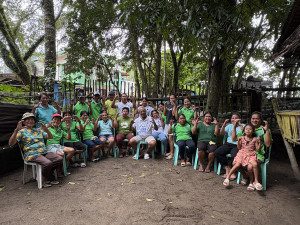
Richard Aquino (center) and his team at Tortosa Pump Boat Association
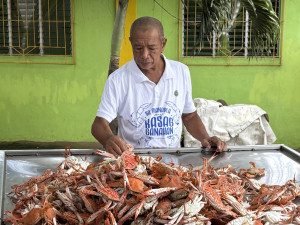
Richard Aquino
Next, we set off to 7 Hectares, traversing a rough dirt road in an off-road vehicle winding through the thick brush of towering sugar cane that offered occasional glimpses of expansive rice paddies and fruit trees along the way. Founded by Kiko Torno, a former advertising executive, 7 Hectares breathes new life into once abandoned fish ponds in Saravia. These ponds, originally used to raise milkfish, have since been transformed under Torno’s vision into a model of sustainable aquaculture.
Upon arrival, we made our way to a clearing, wading through tall grass. To our delight, we discovered a picturesque table setting prepared for a 13-course pond-to-fork degustation menu. Torno’s journey began in 2009. “We started from a place of play, reviving abandoned sea ponds that once supplied global tiger prawns in the 1970s,” he recalled. He emphasized a unique approach by avoiding artificial feeding.
“What makes 7 Hectares special is that all our produce is grown and fed naturally, even down to the plankton,” Torno explained. He collaborates with a team of marine biologists focused on finfish, crustaceans, and mollusks, achieving a balance that maintains the ecosystem.

Kiko Torno. Photo courtesy of Rocio Diaz Arcela
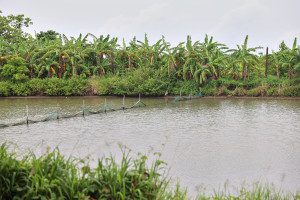
Photo courtesy of Rocio Diaz Arcela
“I work with marine biologists and even took a two-month course at SEAFDEC [Southeast Asian Fisheries Development Center], the hub for seafood research in Southeast Asia. We’ve expanded from one species to eight. This year, I’ve made our ponds the first self-healing aquaculture facility. If one species collapses, others benefit, ensuring that ammonia and oxygen levels are balanced.”
He described the tidal influence on the ponds, just 800 meters from the ocean. “We’re subjected to the species that Mother Nature brings. If the tide comes in, small fish and other creatures pass through canals into our ponds,” he said.

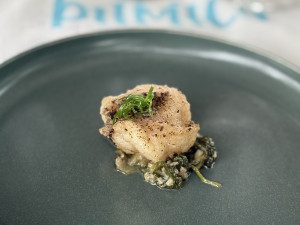
Torno’s goals extend beyond his farm. “As a proponent for slow fish in Asia, I want to gather all seafood advocates to preserve our fishing culture—not just as Filipinos, but as Asians. After all, 75% of the world’s fish supply comes from Asia.”
Pathways to Organic Abundance
Our Slow Food exploration continued at Fresh Start Organic Farm, founded by Slow Food Councilor for Southeast Asia, Chin Chin Uy. His mission is clear: to transform Negros into a fully organic region. With 20,000 hectares of organic land, they are already 8% organic and aim to increase this percentage. The commitment to healthy soil and sustainable agriculture is a testament to their vision for a future where all can access nutritious food.
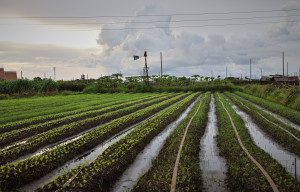
Photo courtesy of Rocio Diaz Arcela
“Our goal is to make everything organic, so farmers can produce their own organic fertilizers and save seeds. This empowers them, unlike conventional methods where they depend on seeds and chemicals from outside.” He continued, “When global oil prices rise, chemical fertilizers become more expensive. We don’t want to be caught in that system. We envision a future where Negros residents can eat organic food, regardless of external circumstances. We’ve been committed to this since 2005, and it’s already been more than 20 years of hard work.”

Photo courtesy of Rocio Diaz Arcela
He elaborated on the motivations behind this shift to organic farming. “Before the 1960s, everything was organic. The shift to chemicals post-World War II has brought significant environmental harm,” says Uy. “Farmers are the poorest in our society despite growing our food. This is a failure we want to change. It’s not going backward to focus on organic practices; it’s moving forward by adopting sustainable, regenerative agricultural methods.”
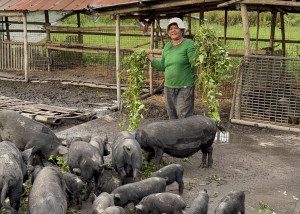
The fruits of labor are evident at Uy’s restaurant, Lanai by Fresh Start, highlighting hyper-local produce. The menu features ‘Ark of Taste’ treasures like batwan, a native sour fruit that adds a delightful tang to many traditional Filipino dishes, especially in savory soups where its vibrant acidity shines. Its flavor profile not only elevates meals but also enriches the culinary tapestry of Negros.

We indulged in what many of us deemed one of the finest salads we’ve ever tasted: the Negros Burrata Salad, made with organic greens from Uy’s farm and local burrata cheese, drizzled with a honey garlic balsamic vinaigrette.

We savored a decadent Tsokolate Negrense, a hot chocolate made from Criollo cacao melted with local carabao milk, finished with asin tibuok—a traditional Filipino sea salt known for its smoky, mineral-rich flavor and fruity undertones. This unique salt, treasured for its taste, is also an endangered heritage food, as traditional methods of production have been overshadowed by a 1995 Philippine law requiring iodization of salt. Fortunately, recent initiatives are working to safeguard this culinary tradition.
In embracing the principles of organic farming, we witnessed a transformative vision taking root in Negros. Uy’s efforts not only highlight the need for sustainable practices but also illuminate the potential for local empowerment through agriculture. The vibrant flavors and ingredients showcased at Lanai are a testament to what can be achieved when we prioritize local traditions and biodiversity.
Christopher Fadriga, the King of Criollo

Christopher Fadriga, Filipino Aromatico Cacao Nursery & Plantation
Christopher Fadriga’s journey into cacao farming began about 11 years ago, sparked by his curiosity about natural farming practices. Encouraged by his mentor to explore the potential of cacao—a crop he believed held a promising future—Fadriga’s intrigue blossomed into a dedicated pursuit.
“Prior to that, I had zero knowledge about cacao,” he said. Following his mentor’s advice, Fadriga visited Davao, where 80% of the Philippines’ cacao is produced. There, he learned how to grow cacao using the Trinitario variety. A hybrid of Criollo and Forastero, this variety was developed to be more resilient and productive, a response to diseases that had nearly wiped out pure Criollo cacao in Latin America.
Recognized as the first heirloom variety of cacao, Criollo hails from the Amazonas region in Peru and has been historically cherished by the Mayas and Aztecs. Today, however, it accounts for less than 1% of global cacao production, largely due to its low yield, vulnerability to disease, and the demanding conditions it requires for growth. This rarity imbues Criollo cacao with exceptional value, renowned for its delicate, complex, and exotic flavor profile. In comparison to other cacao varieties, such as Forastero and Trinitario, Criollo offers a mild, creamy chocolate experience, accented by floral undertones, minimal bitterness, and subtle aromas—qualities that premium chocolatiers hold in high regard. In the Philippines, Criollo cacao holds a distinctive historical significance, as the country is one of the first in Asia—and beyond the Americas—to cultivate this rare variety.
Determined to find remnants of the Criollo variety, Fadriga faced skepticism. “People in Mindanao told me that Criollo was a weak plant and not commercially viable,” he said. Despite this discouragement, he began his search in Cebu, looking for old cacao trees that could yield the coveted white bean pods.
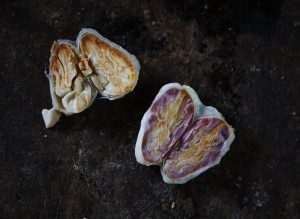
Photo courtesy of Rocio Diaz Arcela
His persistence paid off when he found his first Criollo. “I posted pictures on Facebook, and to my surprise, it caught the attention of foreign cacao traders,” he explained. One of them from Tachibana, an established cacao trading company, visited Fadriga and encouraged him to continue his quest.
Fadriga observed an increasing consumer desire for healthier chocolates, highlighting the growing demand for dark chocolate with less bitterness, a characteristic of the white bean cacao. This realization marked a turning point for Fadriga and validated his efforts.
When Fadriga’s beans were later recognized as one of the top 50 cacao beans in the world, he couldn’t contain his excitement. “We were thrilled when we learned we won gold at the International Cocoa Awards during the COVID-19 period in 2021,” he said. His Criollo was recognized as one of the top 50 cacao beans out of 235 samples from 53 cacao-producing countries globally in this prestigious biennial competition that celebrates outstanding quality cacao growers worldwide. Coincidentally, the announcement came just one day before a strong typhoon struck Negros, making the achievement feel even more significant.
“Being recognized on that level was a dream come true,” Fadriga stated, an affirmation of his commitment to revitalize the cacao industry in the Philippines by preserving the Criollo lineage brought to the archipelago centuries ago.
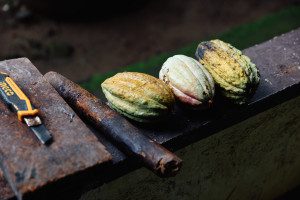
Photo courtesy of Rocio Diaz Arcela
As he continues to champion the legacy of Criollo, Fadriga is forging pathways for others to follow, proving that with dedication and vision, it is possible to revive and redefine the agricultural landscape.
Treasures of Carbin Reef
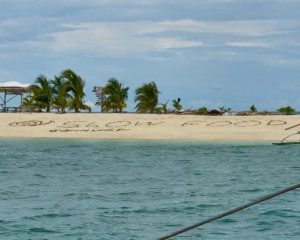
In the heart of the Sagay Marine Reserve in Negros, , surrounded by coral reefs and a white sandbar, , conservation and community intersect, transforming former fishermen into dedicated guides and stewards of the sea, ensuring that both natural resources and traditions are preserved for future generations.
Established in the 1980s, the Sagay Marine Reserve gained international acclaim for its effective marine conservation efforts, particularly in combating illegal fishing. As a protected sanctuary, Carbin Reef serves as a crucial breeding ground and habitat for numerous marine species, replenishing the province’s seafood supply. “That’s why we have fresh seafood—because of the protected seas sustained through global recognition for our conservation efforts,” explains Helen Arguelles, Tourism Officer of Sagay City.

As we stepped off the boat into gentle turquoise tides washing up against our ankles, we were warmly welcomed by the tantalizing aroma of lechon slowly roasting over an open fire. Under a make-shift wooden and bamboo structure draped with white linens, Chef Mark Lobaton from Enting’s Special of Sagay was ready for us with a kinilaw demonstration using freshly caught Spanish mackerel, Indian mackerel, barramundi, and shrimp. Kinilaw is a traditional Filipino dish often compared to “ceviche.” It’s made by marinating raw fish or seafood in vinegar or citrus juice. It embodies the Filipino love for fresh ingredients, communal dining, and the use of local produce. Each region in the Philippines may have its own unique twist on kinilaw, showcasing the diverse culinary heritage of the country. Lobaton’s version is rooted in family tradition, using coconut vinegar as a dipping sauce, allowing the natural flavors and textures of the raw fish to shine.

Photo courtesy of Rocio Diaz Arcela

The kinilaw was an exquisite prelude to the main event—the lechon, a mouthwatering spectacle of crispy skin and tender meat that effortlessly fell apart with each juicy bite. As we savored the flavors of both sea and land, it became clear that this culinary experience was more than just a meal; it represented a crossroads of sustainable practices revitalizing the region and a joyous celebration of cultural cuisine.
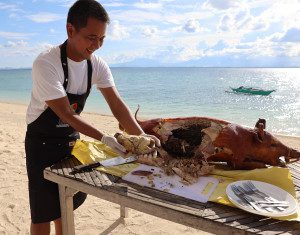
Chef Eric Lobaton. Photo courtesy of Rocio Diaz Arcela
Connecting the Past and Future
It is inspiring to witness how Negros not only champions the Slow Food movement but also sets a precedent for other communities around the world grappling with the complexities of food security and ecological balance. This journey has not only expanded our palates but also deepened our understanding of the vital role that local food systems play in fostering resilience and community.
-
TAGS:
- Food & Beverage